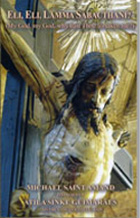Catholic Virtues
 |
 |
 |
 |
 |
 |
 |
St. Anne, Mother of the Glorious Virgin Mary - II
Charlemagne Discovers the Relics of St. Anne
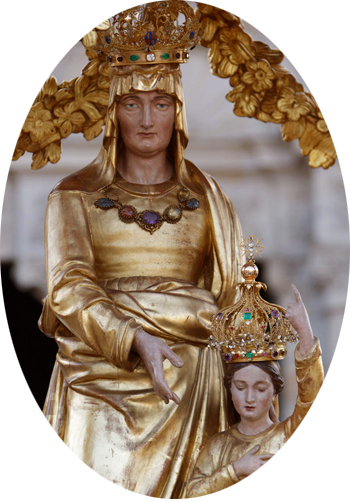
St. Anne & her daughter Mary in royal garb
Beginning in the 6th century, St. Anne’s feast day was celebrated in the East, and churches were built in her honor. In the 8th century, the Syrian Pope Constantine spread her devotion to Rome.
At the dawn of the 9th century, St. Anne’s relics were miraculously discovered, greatly increasing her prestige and inspiring a wonderful series of effects.
St. Anne's body
Not long after the death of Our Lord, a terrible wave of persecutions began. Around the year 47 AD, a notable group of Christians was captured by the Romans and put out to sea in a boat without sails or oars. Among them were St. Mary Magdalene, her siblings Sts. Martha and Lazarus, and Sts. Maximinus and Sedonius. This noble group had in their possession the relics of the body of St. Anne, which they took with them.
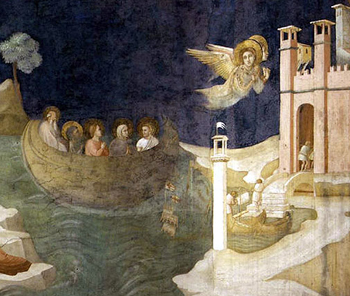
The boat without rudder or sail lands with its precious cargo – the relics of St. Anne – in Apt, Francee
The miraculous passage by sea and the preaching of its passengers made a great impression on the local people of the area, who were converted to the Catholic Faith. Soon a church was built over the spot where the remains of St. Anne had been reverently laid.
Because the area was prey to invasions by the barbarian hordes, the first Bishop of Apta Julia, St. Auspicius, buried this holy treasure in a deep underground chapel whose entrance was known only to a few. That first church fell into decay during the turbulent times of wars and religious persecution that followed, and the site guarding the body of St. Anne was lost in history.
In subsequent centuries, after the Faith began to flourish in Europe, many sought to find the body of St. Anne in Apt. Records proved that she was buried somewhere in the city, but her body had been hidden so well that no one could locate it. To discover it would require divine intervention.
The miraculous discovery
During the time of Charlemagne, peace was restored to the region and a magnificent new cathedral was built on the site over the old chapel. Easter Sunday in the year 792 was the day chosen for its reconsecration.
Charlemagne, along with others of his court, was present for the occasion.
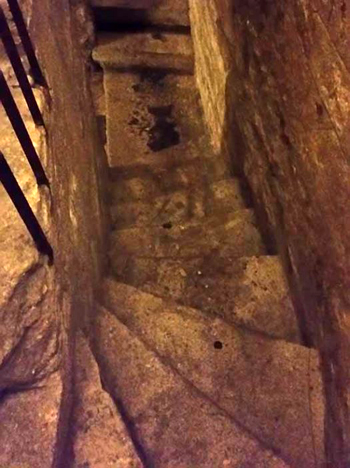
The steps opened to a narrow passageway, still found today in St. Anne Cathedral in Apt
His embarassed ffamily tried to take him away, but neither they nor the royal guards could keep the normally docile youth from returning to the step, which he continued to bang, making signs that they dig there. The eyes of the people turned to Charlemagne to see what he would do.
Recognizing the hand of God in this strange episode, Charlemagne called for workmen after the Mass to come and remove the steps. To their surprise, underneath the steps was a large door that opened to a subterranean passage.
The young boy entered without hesitation, leading the small group, with Charlemagne at its head, down a stairway. He continued down a narrow passageway until they had reached a wall that blocked the way. The boy indicated once again with his stick that it should be removed. This revealed another long passageway, which again the blind boy led them through, as if he were familiar with the way.
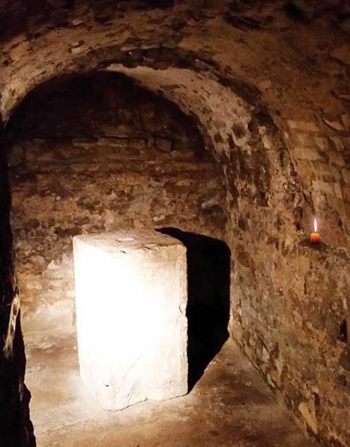
A vigil candle was burning on the wall of the crypt that guarded the relics of St. Anne
As Charlemagne and the entourage in wonder stood before it, the lamp suddenly went out. At that very moment the boy immediately regained his hearing, vision and ability to speak.
“It is she! It is she!” he cried. Charlemagne, not understanding what he meant, nonetheless repeated the words. The call was taken up by the group and then echoed by the crowds in the Church above, who fell to their knees. A profound sacrality permeated the air, and all sensed that in this mysterious passage was something celestial and holy.
Who was she? The townspeople already realized that this was the burial place of the mother of Our Lady, for they knew from tradition that she was buried somewhere under the church.
The workmen opened the door of the crypt. The air smelled sweet, like an Eastern incense, and a casket lay within it. In the casket was an elaborate Oriental winding cloth, and the remains of a body. The inscription atop the relics read, “Here lies the body of St. Anne, mother of the glorious Virgin Mary.”
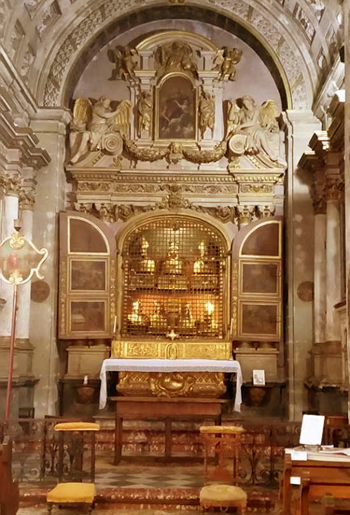
A side chapel in St. Anne’s Cathedral in Apt displays her relics
When the city received the joyful news, they were filled with joy and awe; for three days they only spoke when necessary, and in reverential whispers.
All of this made a deep impression on Charlemagne, who ordered a notary to make a detailed account of the miraculous finding to be sent to Pope Adrian I, along with a letter signed by himself. These documents and the Pope’s reply can still be seen to this day.
The discovery of St. Anne’s relics is all the more beautiful when we recall that Our Lord is her grandson by blood. When Catholics venerate the relics of St. Anne, they also pay tribute to the Son of her daughter Mary, Our Lord.
It is interesting to see how God used a simple youth – deaf, dumb and mute – to bring about the discovery of this great Saint who was mother of the Mother of God. Let us pray that God in His Providence might make use of us, who are slaves of Mary but laden with problems and broken by the Revolution, to help to make St. Anne known and her presence felt during the Reign of Mary that is to come.
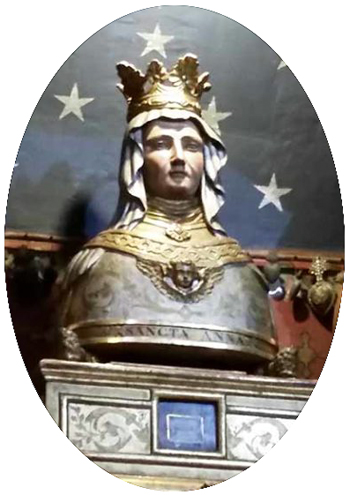
Reliquary of St. Anne
in her Cathedral in Apt

Posted July 29, 2024














